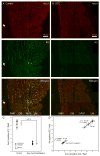Immunoreactivity for Ano1 detects depletion of Kit-positive interstitial cells of Cajal in patients with slow transit constipation
- PMID: 21585622
- PMCID: PMC3138829
- DOI: 10.1111/j.1365-2982.2011.01729.x
Immunoreactivity for Ano1 detects depletion of Kit-positive interstitial cells of Cajal in patients with slow transit constipation
Abstract
Background: Depletion of interstitial cells of Cajal (ICC) is associated with several gastrointestinal (GI) motility disorders. Changes in ICC networks are usually detected by immunolabeling for the receptor tyrosine kinase Kit. Ano1 (DOG1 or TMEM16A) was recently described as a marker of ICC in GI tract. Our aim was to determine whether Ano1 immunoreactivity can be used as a reliable marker for ICC in tissues from patients with motility disorders.
Methods: Four tissues from patients with normal ICC numbers and four tissues from patients with slow transit constipation and loss of Kit-positive ICC were studied. Interstitial cells of Cajal were detected by double labeling using antisera to Kit and Ano1.
Key results: Both the processes and cell bodies of ICC in tissue from controls and slow transit constipation were immunoreactive for Ano1. There was a near complete overlap between Kit and Ano1 immunoreactivity. Tissues from patients with slow transit constipation contained significantly fewer Ano1-positive ICC than control tissues. The numbers of ICC identified by Ano1 and Kit immunoreactivity were nearly identical across the range of ICC numbers from an average of 1.64 to 7.05 cells per field and correlated with an R(2) value of 0.99.
Conclusions & inferences: Ano1 is a reliable and sensitive marker for detecting changes in ICC networks in humans. Labeling with antibodies selective for Ano1 reproducibly detects depletion of Kit-positive ICC in tissues from patients with slow transit constipation.
© 2011 Blackwell Publishing Ltd.
Conflict of interest statement
Competing interests: The authors have no competing interests.
Figures


Similar articles
-
Discrepancies between c-Kit positive and Ano1 positive ICC-SMP in the W/Wv and wild-type mouse colon; relationships with motor patterns and calcium transients.Neurogastroenterol Motil. 2014 Sep;26(9):1298-310. doi: 10.1111/nmo.12395. Epub 2014 Jul 14. Neurogastroenterol Motil. 2014. PMID: 25039457
-
Ano1 is a selective marker of interstitial cells of Cajal in the human and mouse gastrointestinal tract.Am J Physiol Gastrointest Liver Physiol. 2009 Jun;296(6):G1370-81. doi: 10.1152/ajpgi.00074.2009. Epub 2009 Apr 16. Am J Physiol Gastrointest Liver Physiol. 2009. PMID: 19372102 Free PMC article.
-
Expression of anoctamin 1/TMEM16A by interstitial cells of Cajal is fundamental for slow wave activity in gastrointestinal muscles.J Physiol. 2009 Oct 15;587(Pt 20):4887-904. doi: 10.1113/jphysiol.2009.176198. Epub 2009 Aug 17. J Physiol. 2009. PMID: 19687122 Free PMC article.
-
Interstitial cells of Cajal and human colon motility in health and disease.Am J Physiol Gastrointest Liver Physiol. 2021 Nov 1;321(5):G552-G575. doi: 10.1152/ajpgi.00264.2021. Epub 2021 Oct 6. Am J Physiol Gastrointest Liver Physiol. 2021. PMID: 34612070 Review.
-
Role of Ano1 Ca2+-activated Cl- channels in generating urethral tone.Am J Physiol Renal Physiol. 2021 Apr 1;320(4):F525-F536. doi: 10.1152/ajprenal.00520.2020. Epub 2021 Feb 8. Am J Physiol Renal Physiol. 2021. PMID: 33554780 Review.
Cited by
-
Recent advances in intestinal smooth muscle research: from muscle strips and single cells, via ICC networks to whole organ physiology and assessment of human gut motor dysfunction.J Smooth Muscle Res. 2019;55(0):68-80. doi: 10.1540/jsmr.55.68. J Smooth Muscle Res. 2019. PMID: 31956167 Free PMC article.
-
Aging-dependent decrease in the numbers of enteric neurons, interstitial cells of Cajal and expression of connexin43 in various regions of gastrointestinal tract.Aging (Albany NY). 2018 Dec 11;10(12):3851-3865. doi: 10.18632/aging.101677. Aging (Albany NY). 2018. PMID: 30530917 Free PMC article.
-
Role of Tenascin-X in regulating TGF-β/Smad signaling pathway in pathogenesis of slow transit constipation.World J Gastroenterol. 2020 Feb 21;26(7):717-724. doi: 10.3748/wjg.v26.i7.717. World J Gastroenterol. 2020. PMID: 32116419 Free PMC article.
-
Understanding the Biology of Human Interstitial Cells of Cajal in Gastrointestinal Motility.Int J Mol Sci. 2020 Jun 25;21(12):4540. doi: 10.3390/ijms21124540. Int J Mol Sci. 2020. PMID: 32630607 Free PMC article. Review.
-
The Relationship Between Colonic Macrophages and MicroRNA-128 in the Pathogenesis of Slow Transit Constipation.Dig Dis Sci. 2015 Aug;60(8):2304-15. doi: 10.1007/s10620-015-3612-1. Epub 2015 Mar 7. Dig Dis Sci. 2015. PMID: 25749934
References
-
- Farrugia G. Interstitial cells of Cajal in health and disease. Neurogastroenterol Motil. 2008;20 1:54–63. - PubMed
-
- He CL, Burgart L, Wang L, et al. Decreased interstitial cell of cajal volume in patients with slow-transit constipation. Gastroenterology. 2000;118:14–21. - PubMed
-
- Wedel T, Spiegler J, Soellner S, et al. Enteric nerves and interstitial cells of Cajal are altered in patients with slow-transit constipation and megacolon. Gastroenterology. 2002;123:1459–67. - PubMed
-
- Forster J, Damjanov I, Lin Z, Sarosiek I, Wetzel P, McCallum RW. Absence of the interstitial cells of Cajal in patients with gastroparesis and correlation with clinical findings. J Gastrointest Surg. 2005;9:102–8. - PubMed
Publication types
MeSH terms
Substances
Grants and funding
LinkOut - more resources
Full Text Sources
Other Literature Sources
Medical

